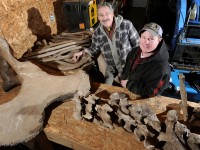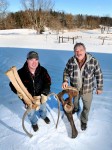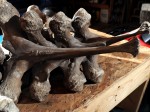 Contractor Daniel LaPoint Jr. was digging a poind with an excavator on his neighbor Eric Witzke’s property in Bellevue Township, southern Michigan, last November when he noticed a large bone jutting out of the pile of displaced soil. He pulled it out of the pile and saw it was a curved bone four feet long. Over the next four days, LaPoint and Witzke dug up the yard and unearthed 41 more large bones which at the time they assumed were dinosaur bones due to their impressive dimensions.
Contractor Daniel LaPoint Jr. was digging a poind with an excavator on his neighbor Eric Witzke’s property in Bellevue Township, southern Michigan, last November when he noticed a large bone jutting out of the pile of displaced soil. He pulled it out of the pile and saw it was a curved bone four feet long. Over the next four days, LaPoint and Witzke dug up the yard and unearthed 41 more large bones which at the time they assumed were dinosaur bones due to their impressive dimensions.
They enlisted the aid of Daniel Fisher, director of the University of Michigan Museum of Paleontology, who examined the bones and determined they were from a mastodon, not a dinosaur, and are between 10,000 and 14,000 years old.
LaPoint and Witzke’s collection includes several rib bones, leg, shoulder and hip bones, the base of a tusk and pieces of the animal’s vertebrae.
Fisher has spent several hours looking through what they found and believes the mastodon was a 37-year-old male.
“Preliminary examination indicates that the animal may have been butchered by humans,” said Fisher. Bones show what look like tool marks, in places.
 Only 330 confirmed mastodon bones have been found in Michigan, so the discovery of 42 in one place is exceptional. Fisher believes there may be more bones to be found in Witzke’s yard, but the wet earth was already difficult to excavate in November. It’s probably close to impenetrable in full winter.
Only 330 confirmed mastodon bones have been found in Michigan, so the discovery of 42 in one place is exceptional. Fisher believes there may be more bones to be found in Witzke’s yard, but the wet earth was already difficult to excavate in November. It’s probably close to impenetrable in full winter.
The finders could make a few thousand dollars off the bones if they sold them, but they are awesome people so they’ve decided to keep a few bones as mementos and donate the rest to the museum. The bones will go to the museum at the end of the month. Once they’re there, researchers will radiocarbon date them to narrow down the date range to within a few hundred years.
 In further evidence of LaPoint and Witzke’s awesomeness, the pair took the bones to the local middle school so the kids could get the hands-on experience before they disappear into the museum’s stores.
In further evidence of LaPoint and Witzke’s awesomeness, the pair took the bones to the local middle school so the kids could get the hands-on experience before they disappear into the museum’s stores.
“Once these things go to the museum and get crated up, you’re not going to get to touch them again. It’s over with and I was that kid who wanted to touch that thing on the other side of the glass,” said LaPoint. “All the kids got to pick them up and hold them. Some kids, it was life-changing for them. To change one kid’s life because they got to touch it, I think, is an incredible opportunity.”